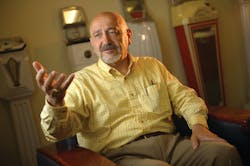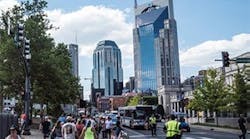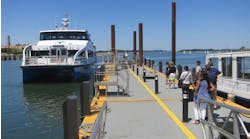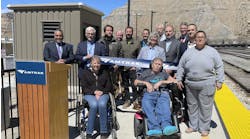[Image: Volk. Caption: Volk says you have the community to look at, your capital funding, your operating funding, the infrastructure, the employees, the board, a variety of things to consider as to whether to stay or move on. “Whenever I looked at them, we were always the favorable one.”]
Four years. That was about how long Champaign-Urbana Mass Transit District (MTD) Managing Director Bill Volk and his wife were expecting to stay in the area before he would move on to a different location. It’s been a little more than that, that’s he’s been at MTD … like more than 30 years.
After talking to him and other staff for a day at MTD, it seems a pretty common thread that once you come to MTD, you don’t want to leave.
That would lead in to one of the challenges that they are currently looking at: a senior workforce looking to retirement. One of those in that group, Dave Moore, director of maintenance, laughs, “At over 30 years, I’m the ‘new guy.’ And they let me know that.”
Volk says, “At this point, we have some of the people talking about the grey hairs getting out and the people who are talking about retiring are mostly department heads.” Matter-of-factly he adds, “In many cases the whole concept [succession planning] is overblown and this has been going on forever. People have been leaving and dying and retiring so in our case, we’re going to have a number of people leaving at the same time.”
With Volk’s contract ending June 30, 2014, and a number of other people most likely going at that time, he says they have a pretty good idea of who could be moved into which positions and that there will be more than enough time for people to continue to do the training that’s necessary to bring them up to speed.
He makes it sound pretty simple, but it took laying a foundation, building the culture core values and utilizing a management system that enforces documentation so that the next generation is more than capable of continuing to operate the system at the same level.
A Start in Transit
[Volk caption: One of the reasons Volk attributes MTD being an attractive place to stay is it consistently receives good funding. While Chicago gets a lot of transit money, it helps all of the state, Volk says.]
Volk’s first experience with buses was when he worked for Greyhound while in High School. Then when he went to Indiana University, the business school had a concentration in transportation. “At that point 25 percent of the GDP was in transportation, so I figured there must be a lot of jobs.”
He had a course with George Smerk and he was hooked. Since he decided transit was what he was going to do, he figured he should get experience so he went to work at the campus bus system cleaning buses. “And I was an absolutely terrible employee,” he says. “They should have fired me; I don’t know why I wasn’t.”
But then the next semester he started driving and then he got a job as an intern, and eventually as a supervisor at Fort Wayne. After a year there, he applied for the MTD position. “And I didn’t get it,” he says. “And it’s a good thing I didn’t.”
The next year there was route cutting and he was working through that problem there was a valuable experience.
Volk and MTD were our cover story in June 2002 and the article is on www.MassTransitmag.com you can read more about the strategic planning they were doing at the time, how MTD first started its partnership with the university and more details on the decertification of the union.
There’s a lot of interesting information in the previous article that I won’t repeat here, as this trip was to focus on what MTD has done to be more sustainable: as an organization and for the environment.
Environmental Management System
[Karl_Knadt caption: Once they submit their EMS case study to the FTA, Knadt says they will go out to bid on an ISO registrar for them to come in and do their audit and certification.]
MTD recently went through Virginia Tech’s Center for Organizational and Technological Advancement’s (COTA) Environmental Management System (EMS) Implementation Institute. COTA explains an environmental management system as a set of management processes and procedures that allow an organization to analyze, control and reduce the environmental impact of its activities, products and services and operate with greater efficiency and control.
Virginia Tech offers an Environmental & Sustainability Management System transit training using the ISO 14001 standard. Director of Market Development Karl Gnadt at MTD explains it’s an intensive program.
“We went out to Roanoke four times, there were four week-long classes.” Each time he says they would take five or six people out and with an organization the size of MTD, that’s quite a challenge in and of itself. “That was a third of our staff that we were taking.”
It’s about a year-and-a-half process and MTD just completed the institute in February of this year. After the final week-long class, one of the faculty does a site visit and a final audit.
The program really forces you to document everything and to track and monitor things, Gnadt says. “We had done some big projects: we put the permeable pavers down, the geothermal system, and would move on to the next thing.” He states, “That’s kind of the mold we were in.
“This kind of forces us to take a more global approach to it and say, OK, these are things we need to do, this is what we do to follow up, how we plan for the next one, how we monitor and how we manage the systems that we are putting in place.”
An example he cited was with their maintenance department. With Dave Moore looking to retire in the next couple of years, “He is a wealth of knowledge and when he’s gone, there will be a dearth of knowledge. So this helps us to bridge that because more of his knowledge will be documented in the process. The thought process that he goes through documented.”
[Davied_Moore caption: Moore says they have hybrid buses and right now they haven’t had to deal with the batteries but the issue of disposing them will come up and with EMS, he says they start to focus on things like that now instead of all of a sudden having to make a decision without a thought-process in place.]
Moore says, “It basically redefines it in a very organized system for the next people, so they know what we have been doing in the past and so they know how to continue in the future.”
Talking to Gnadt about the other agencies in the program at the same time, he says it doesn’t matter what size an organization is. “It was kind of nice because we were able to all hear about the same thing, talking about the same thing, so we had different experiences with the different-sized systems from different states.” He says, “It enabled a lot of really good sharing and conversation between the systems.”
And it sounds like there are some definite advantages and disadvantages, no matter what your size. With a small agency, when MTD staff would come back to do the homework and follow up, Gnadt says with a very small group of people doing that and those being the same people significantly involved in running the organization, it’s very challenging in terms of resources.”
But the large system has a very different challenge. “They’ve got that core group of people that focus on it, but they’ve got to sell it to everyone else,” Gnadt says. “The core group, the EMS team has bought into it and we didn’t have to sell it, because we already bought in to it. We understand this is where we are, at a critical juncture with our organization.
We had so much longevity with employees and with a number of them retiring, it’s critical for us to figure this transition out and to manage it, he states.
Green Initiatives
Illinois Terminal Manager Adam Shanks says the EMS process really gets you to think about your green initiatives, though he adds, “Since I’ve been here, they’ve always been forward-thinking about the environment and how some of these amenities could help us meet mixed-use transportation.
“I’ve heard about that since I started here: walking, biking, transit in general, as well as dealing with traffic congestion and creative ideas in how to deal with that.”
Volk says a lot of the sustainability initiatives got started with ARRA funding, though the decision to move in that direction had come sooner. “We had made the decision before that we wanted to do sustainability because we’re going to market to a community that we were the green alternative.”
[Pavers]
The first thing I noticed when arriving at MTD was the parking lot covered with permeable pavers to allow rain and melted snow to enter the groundwater system. In 2010 MTD covered its administration building with a white roof that reflects more than 70 percent of sunlight. Also in 2010, a geothermal cooling and heating system was installed.
Both Volk and Shanks say there were significant changes made at the Illinois Terminal, including the installation of a new chiller that is scheduled to be complete by the end of this year. The system allows for the storage of cooling energy as ice to offset the cooling load during peak hours. And once they get the chiller in, they will be able to get LEED certification for an existing facility.
With various sustainable changes they’ve made in their buildings, they may not have seen cost savings, but, Volk says they haven’t had any cost increases even though utility costs in general have gone up.
As for the vehicles, two major green initiatives have been converting to hybrid vehicles and for operator training, not training them on the vehicles. Safety and Training Director James Dhom has simulators to work with, which were installed in 2010. Dhom says, “You can save time and fuel on the bus because you can cover much of the information in here, in a semi-read setting.”
[James_Dhom caption: Training simulators by FAAC are not only green, MTD has seen lower operator accident rates and Dhom asys the simulators are a part of that because they better prepare operators.]
Not only the operators, but most all employees at MTD have their Commercial Driver’s License, so they are trained on the simulators, as well. Aside from being a smaller agency and it being beneficial in case of emergencies, it also reminds all employees what it takes to operate a bus.
The simulators are set up to look and feel like you’re in the vehicle and the trainer can “load” which bus is being driven, whether it’s one of their 30-foot El Dorados or a 60-foot New Flyer artic. And then the trainer can tailor exactly what kind of scenario is going to be presented.
Different “worlds” can be loaded: country, county, urban, garage stalls and garage situations and in the case of MTD, a customized world. “All of our buses except for about two routes go through campus,” Dhom explains. “It’s not as bad as Chicago, still, you’re talking about a 14-block area with 42,000 students and 17,000 faculty. Big time problems for us.
“In addition to purchasing the general worlds that we got from FAAC, we got a customized one for our campus area. We can show our campus area and the problems that we are having.” Dhom explains that they can look specifically at what accidents are occurring and where, and then focus in on those specific scenarios.
[Buses caption: MTD’s hybrid vehicles have seen an increase of 30 percent in miles per gallon for the 30-footers, 20 percent for the 40-foot and 20 to 21 percent for the artics.]
When it comes to the actual vehicles at MTD, Moore says they got their first hybrid in 2009 and had been looking at alternative fuel options since the early to mid-2000s. “The Allison hybrid system was coming out and it had gained a reputation of what people describe as a bulletproof system; it was doing well.
“We knew we were going to take that next step but we knew we had to go with a system that was proven.” He continues, “So in 2009 we pulled the trigger and we got these 30-footers and 60-footers from New Flyer. We had very good luck with them and then in 2011 we got 23 40-footers and then in 12 we got 12 more.”
The biggest question from peers about converting, he says, was what did they have to change in their infrastructure or process to handle hybrids. “And my answer is nothing,” he says. “I mean, literally, there was no training, other than training which is involved when you buy a fleet, but other than that, there was nothing and you get them out on the street every day.”
ACTIVE TRANSPORTATION
In the community, ridership has been up 9 to 10 percent, walking and biking rates are up and vehicle miles traveled have leveled off and actually decreased in the University District. A similar indicator is that the purchase of parking permits has gone down in both cities and the University the last two years. Though it wasn’t always that way.
[Cynthia_Hoyle caption: Hoyle says MTD has partnered with the schools, law enforcement, the health community and the bicycling community to facilitate reducing childhood obesity by encouraging active transportation.]
Transportation Consultant Cynthia Hoyle was brought on because the city would inform MTD of new developments after it had gone to the planning commission, which is after a lot of time and money had already been spent. “They needed someone in the door earlier so I began attending the meetings.
“I used to joke that my job was to ask how the pedestrian got from the street to the store.” She says, “I don’t have to ask that question anymore. The cities have really moved forward and adopted plans for active transportation.”
Hoyle says one of the best things to happen was when the health community started saying that the build environment is impacting our health. “It’s hard to argue with that.” She says they have just gotten their third Safe Routes to School grant and that has had an impact on the community, as well.
“You create the infrastructure for children to walk and everyone can use that.” She adds, “You talk about safe routes for kids and only the worst curmudgeon in the world is going to come in and object to that.
“Occasionally that will happen, but most people are like, ‘Wow, what a creeper.’”
As for bikes, Urbana is a Bicycle Friendly Community Bronze Level from the League of American Bicyclists and MTD is a Bicycle-Friendly Business Silver. There is a process so you know what you need to do to move forward in becoming more bicyle friendly and having that designation is something MTD can brag about to students.
[Bike_Repair caption: Bike repair stations contain all the necessary tools one would need to change a tire or fix a seat, or other minor repairs.]
Shanks says in addition to bike racks at the Illinois Terminal, they also have six bike lockers that they rent monthly, quarterly or annually and they have bike repair stations. Each city has a unit they are responsible for and MTD maintains the one at the Illinois Terminal. “We go out and check to make sure that everything is in good order, the tools are usable. The only thing we’ve had to do in about a year and a half, the only thing that’s actually broken on it thus far is the bike pump, which makes sense because it gets a lot of usage.”
He says, “We’ve attempted to partner with the biking community as another alternative means in order to support multimodal transportation.” He continues, “I don’t see why we wouldn’t embrace most every part of that.”
Of all that they’ve accomplished and ventured into, Volk says, “Our board has been willing to go in to take some risks and go into different things.” He also says of MTD’s accomplishments, “I don’t think there’s any formula. It’s recognizing the situation and then taking advantage of it.”



